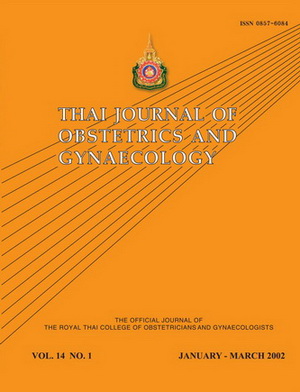The Conservative Management of Anembryonic Pregnancies and Embryonic Death
Main Article Content
Abstract
Objective To study the outcome of the conservative management of anembryonic pregnancy
and embryonic death in a 4-week period.
Design Descriptive study.
Setting Department of Obstetrics and Gynecology, King Chulalongkorn Memorial Hospital.
Methods A prospective descriptive study was performed in women with ultrasound diagnosis
of anembryonic pregnancy or embryonic death (CRL ³ 5 mm.) who chose to have conservative
management. The patients who met inclusion criteria were followed up weekly up to 4 weeks
or until spontaneous abortion occurred. The data on the medical, gynecologic and obstetric
history, symptoms of abdominal pain and vaginal bleeding, gestational age at diagnosis and
sonographic findings were recorded at first visit and ultrasound scans were repeated
weekly up to 4 weeks or until spontaneous abortion was diagnosed. A D&C was done when
spontaneous complete abortion had not occurred after a complete 4-week follow up or
whenever heavy bleeding, severe abdominal pain, or incomplete abortion was encountered or
when the patient desired to undergo D&C. The data were analyzed by means of descriptive
statistics.
Result Eighty-seven women met inclusion criteria. Six cases dropped out because of
anxiety and inconvenience to follow up and one case was excluded because the diagnosis
of molar pregnancy was made after a 3-week follow up. The remaining 80 women were
completely followed up for a four-week period or until spontaneous abortion occurred.
Thirty-eight women (47.5%) had anembryonic pregnancy and forty-two (52.5%) women had
embryonic death. Spontaneous abortion occurred in 64 out of 80 cases (80%) within a
four-week period. Among these 64 spontaneous abortions, 35 cases (43.75%) were
spontaneous complete abortion and 29 cases (36.25%) were spontaneous incomplete
abortion. The highest rate of spontaneous abortion occurred within the first week. There was
no serious complication among subjects who were conservatively managed.
Conclusion The conservative management might be feasible for anembryonic pregnancy and
embryonic death. The highest rate of spontaneous abortion occurred in the first week, which
may be suggested as a “waiting-period” after the diagnosis of anembryonic pregnancy or
embryonic death is made.
and embryonic death in a 4-week period.
Design Descriptive study.
Setting Department of Obstetrics and Gynecology, King Chulalongkorn Memorial Hospital.
Methods A prospective descriptive study was performed in women with ultrasound diagnosis
of anembryonic pregnancy or embryonic death (CRL ³ 5 mm.) who chose to have conservative
management. The patients who met inclusion criteria were followed up weekly up to 4 weeks
or until spontaneous abortion occurred. The data on the medical, gynecologic and obstetric
history, symptoms of abdominal pain and vaginal bleeding, gestational age at diagnosis and
sonographic findings were recorded at first visit and ultrasound scans were repeated
weekly up to 4 weeks or until spontaneous abortion was diagnosed. A D&C was done when
spontaneous complete abortion had not occurred after a complete 4-week follow up or
whenever heavy bleeding, severe abdominal pain, or incomplete abortion was encountered or
when the patient desired to undergo D&C. The data were analyzed by means of descriptive
statistics.
Result Eighty-seven women met inclusion criteria. Six cases dropped out because of
anxiety and inconvenience to follow up and one case was excluded because the diagnosis
of molar pregnancy was made after a 3-week follow up. The remaining 80 women were
completely followed up for a four-week period or until spontaneous abortion occurred.
Thirty-eight women (47.5%) had anembryonic pregnancy and forty-two (52.5%) women had
embryonic death. Spontaneous abortion occurred in 64 out of 80 cases (80%) within a
four-week period. Among these 64 spontaneous abortions, 35 cases (43.75%) were
spontaneous complete abortion and 29 cases (36.25%) were spontaneous incomplete
abortion. The highest rate of spontaneous abortion occurred within the first week. There was
no serious complication among subjects who were conservatively managed.
Conclusion The conservative management might be feasible for anembryonic pregnancy and
embryonic death. The highest rate of spontaneous abortion occurred in the first week, which
may be suggested as a “waiting-period” after the diagnosis of anembryonic pregnancy or
embryonic death is made.
Article Details
How to Cite
(1)
Vaivanijkul, B.; Samritpradit, P.; Uerpairojkit, B.; Charoenvidhya, D.; Tanawattanacharoen, S.; Manotaya, S.; Wacharaprechanont, T.; Tannirandorn, Y. The Conservative Management of Anembryonic Pregnancies and Embryonic Death. Thai J Obstet Gynaecol 2017, 14, 13-20.
Section
Original Article


